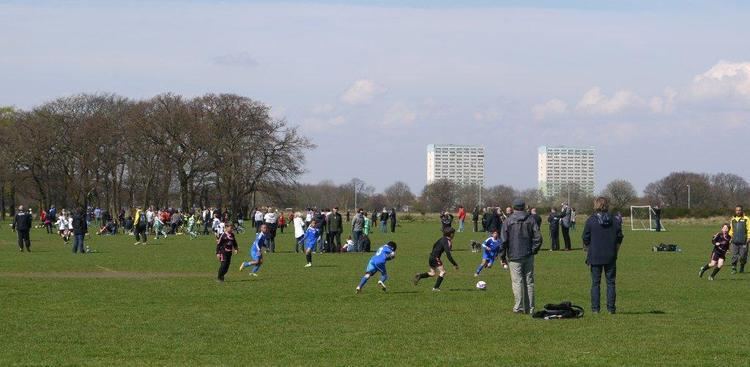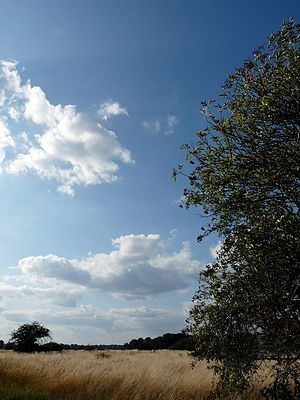 | ||
Rough guide to wanstead flats
Wanstead Flats is the southernmost portion of Epping Forest in eastern London. It falls within the boundary of the London Borough of Redbridge.
Contents
- Rough guide to wanstead flats
- Wanstead flats from the air shot with gopro hero2
- Geography
- History
- London 2012 police hub
- Water
- Plants
- Access
- References

Wanstead flats from the air shot with gopro hero2
Geography

Wanstead Flats is surrounded by the heavily built-up areas of Leytonstone to the west, Wanstead to the north with Manor Park and Forest Gate to the southeast and south respectively. To the north-west it is connected by way of Bush Wood to Leyton Flats, and to more northerly reaches of Epping Forest.

Roads and houses almost completely surround Wanstead Flats. To the east a low wall and high railing separate it from the City of London Cemetery. Three roads actually cross the Flats, effectively dividing it into four sections. The greater part of the whole area of some 1.35 square kilometres (334 acres) is flat, open grassland on the river gravel of the Taplow Terrace, which overlays the London Clay.
History

Though historically part of a royal forest, the nature of the area encouraged people to turn out cattle and other animals to graze upon this unenclosed land. This practice was eventually recognised and granted as the right of common pasture. Certain landowners and occupiers still have this right, granted them as part of the Epping Forest Act 1878, and cattle grazed freely until 1996 when the BSE crisis forced their removal. It is probable that continued grazing on this and similar areas of the Forest helped to maintain the open aspect which they have today. Although the campaign to prevent enclosure before 1878 is well known, less well known is the campaign organised by local people to prevent the building of houses for 7000 people on part of Wanstead Flats in 1946/47.

In March 2010 the area surrounding Alexandra Lake was cordoned off following the deaths of more than 80 wild birds. Two men, Mark Page and Terrance Webb, were subsequently arrested on suspicion of illegally dumping chemical pesticides near the lake. The two men each admitted two counts of using a pesticide without approval and two counts of theft.
London 2012 police hub

On 16 November 2010, a planning application was submitted by the Metropolitan Police to the London Borough of Redbridge to build a police hub on Wanstead Flats. This planning application was granted, and subsequently a Parliamentary Order (the Legislative Reform (Epping Forest) Order 2011) allowed the police to erect a "muster, briefing and deployment centre" on Wanstead Flats from 23 June 2012 to 20 September 2012, for the purposes of the 2012 Olympic and Paralympic Games. The Centre was removed after the Games had ended.
Water
Much of the land is liable to a degree of flooding after heavy rain, but also to considerable and quite rapid drying-out in periods of low rainfall. Drainage from the grassland should help to maintain usually three permanent open waters. The largest of these, with two islands to its credit, is Alexandra Lake. Its local name the Sandhills Pond may be attributed to the sandy nature of the low gravel mounds by its banks. The next in size is Jubilee Pond, which until 2002 was known as the Model Yacht Pond or Dames Road Pond. Until renovation in 2002 this had stone banks, and, as its name implied, was in the past used for model boating. Lack of repair and a water supply meant that for many years the pond was often dry.
The smallest water is the round pond by Capel Road, Angel Pond. This was named after Lewis Angell, the first borough engineer of West Ham, who was responsible for the construction of the pond during the winter of 1893-94. The spelling soon became corrupted, as early postcards show. This is a circular muddy hollow which can dry out completely in hot weather. The only other semi-permanent pond is that by Lake House Road known as the Cat and Dog Pond, presumably because it only exists when it has been raining 'cats and dogs'.
There are some drainage ditches, but few hold water for much time. The only running water used to be a year-round spring that was the source of one of the 'marshy' areas dominated by rushes that exist in some of the more poorly drained parts of the Flats. The spring, however, is now usually dry. During a period of lake creation at the turn of the 19th/20th Century (when, for example, Alexandra Lake was created as part of a job creation scheme for the unemployed) it is said that the hollow at the junction of Aldersbrook Road and Centre Road was dug. It was supposed to have been a lake, but was not completed.
Plants
Scattered over the area are some thickets of gorse and broom, as well as a number of small woods and copses. Most of these were planted towards the end of the 19th century as a response to efforts by the Epping Forest Committee to break up what was perceived as a monotonous area of grassland. Together with the many trees lining the roadsides and some avenues, they do add greatly to the diversity of tree species to be found. Older than these is an avenue of trees in the NW portion of the Flats, running from close to Ferndale Road in Leytonstone to Bush Wood. This is known as Evelyn's Avenue, planted by John Evelyn (author of Sylva, or a discourse of Forest-trees) on the instructions of Sir Josiah Child after he had purchased the estate. It formed one of a number of such avenues radiating from Wanstead House. Consisting of sweet chestnuts and forming one of the main approaches to Wanstead House, it is remarkable that so much of this is still visible after 300 years.
Access
Nearly all the perimeter of Wanstead Flats has a ditch, often with a bank, to prohibit vehicular access. The only vehicles normally allowed are service vehicles and bicycles. Horses may be taken onto the Flats and are supposed to keep to bridle paths marked by posts. There is considerable pedestrian traffic because of the large number of people living nearby and the availability of the area for activities such as the flying of model aircraft and kites, bird watching, botanising and the exercising of people and dogs.
Portions of the Flats are also maintained as football pitches. Fishing in Alexandra Lake is no longer undertaken and model boating in the old Model Yacht Pond ceased when the pond no longer retained water. The area near the petrol station on Aldersbrook Road (where the sports rooms are) was used in the 1940s to house German prisoners of war. At the pointed junction of Blake Hall Road and Aldersbrook Road is a deep dip in the grass area. This was a World War II bomb crater. After the raid a wrecked United Dairies Milk lorry was found in the crater.
A weekly parkrun event is held on the western section of the flats, with the start at the Harrow Road Pavilion. The course is a two lap figure-of-eight, on a mixture of woodland paths and the edge of the football pitches.
